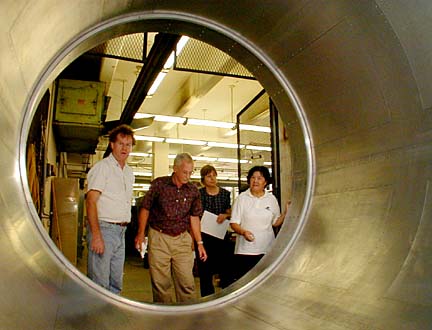Advertisement - Click to support our sponsors.


UH scientists University of Hawaii-Manoa physicists and technicians planned today to display a sample of their high-tech expertise: a massive, high-precision chamber designed and built for China's Beijing Spectrometer.
show off high tech
with precision
chamber for China
The aluminum tube will
be used in the Beijing
Spectrometer to study
subatomic particlesBy Helen Altonn
Star-BulletinThe first such instrument developed at UH, it is an aluminum cylinder about 8 feet long, 7 feet wide and weighing about 3,000 pounds, said Frederick Harris, with the High Energy Physics Group.
It took two years just to build a machine to drill more than 28,000 extremely precise holes on end plates for the device, he said. They could be no more than two-thousandths of an inch.
"It's one at a time, too -- about a minute a hole," Harris said.
The special drill machine was designed and built by Tom Conlon in the Engineering Support Facility of the School of Ocean, Earth Science and Technology at Manoa.
The chamber's outer cylinder was constructed "under very tight tolerances" at Bear Machinery in Kaneohe. It comprises six aluminum plates in which windows were cut to allow for wire stringing. End plates were mounted after it was delivered to the campus in June.
Rongguang Liu of China has been here more than a year working on the project, and other Chinese visitors stayed for long periods to help with the drilling, measuring and alignment, he said.
"It is politically important and good for international relations and contacts between physicists and friendships."
High-energy physics involves the study of subatomic particles that are the building blocks of matter to try to explain the fundamental forces in the universe.
The new chamber will be air-shipped within two weeks to China, where it will take another year to complete, Harris said.
About 23,000 high-voltage wires the size of a human hair must be strung by hand -- a job that will be done around-the-clock.
Filled with gas and strung with the wires, a drift chamber at the center of high-energy colliders traces the trajectories of charged particles produced in collisions between beams of particles traveling at nearly the speed of light. The chamber measures the travel time of particles, which allows their velocity to be determined so the particles can be identified.
The Beijing accelerator was upgraded in 1995-96 by the Chinese and a mainland group to improve its capabilities, but serious problems developed in the chamber, Harris said. The problems eventually were corrected, but the accelerator isn't working as well as it should, he said.
"The data we've been taking the last three years has been on that patched drift chamber," he said. "Now, the worry is that it won't last forever. Each year, we pray that it's going to last one more year."
The U.S. Department of Energy provided about $300,000 for a replacement chamber. The task was split between UH and Colorado State University, with the Hawaii group doing the major work.
The physicists hope to begin using the collider with the new chamber in 2002.
Among other things, they want to confirm the existence of glue-balls -- particles made entirely out of gluons, which are particles that hold quarks together to form hadrons. Quarks are part of what makes up an atom. Neutrons and protons are examples of hadrons.
"There is still physics to be done here, and Beijing is the only place in the world to do it, in that energy region," Harris said.
University of Hawaii